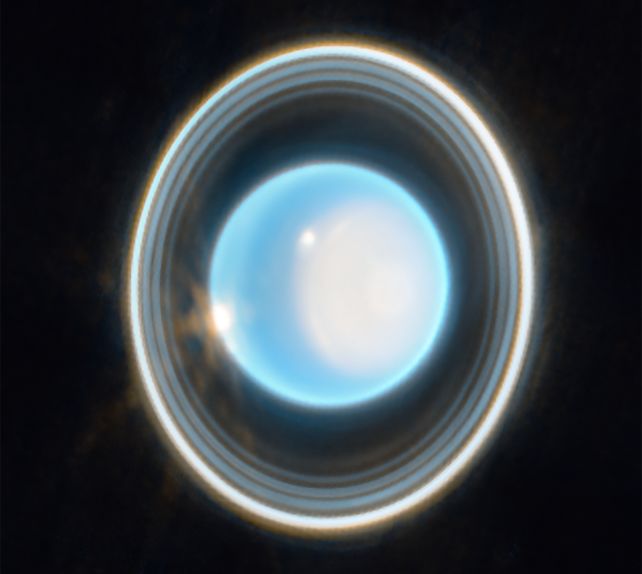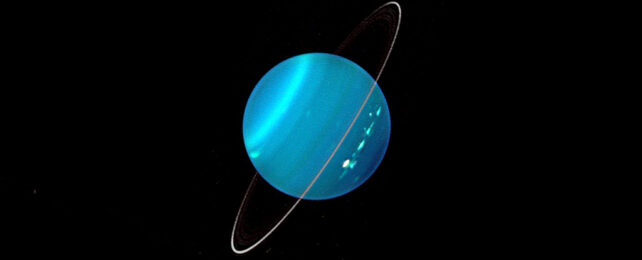Uranus is the seventh planet that orbits the Sun, positioned between Saturn and Neptune at an average distance of just over 2.9 billion kilometers (about 1.8 billion miles).
In spite of being the third largest planet in the Solar System and 50,000 kilometers (31,500 miles) wide, the gray-blue behemoth is too far from Earth to be seen with the naked eye. It was only with advances in telescopy in the late 18th century that a German-born British astronomer by the name of William Herschel stumbled across it while hunting for comets.
His name for the object – Georgium Sidus (after King George III) – failed to catch on. Likewise, other suggestions to name it after Herschel, and an early attempt to make use of the name of the oceanic deity, Neptune, didn't stick. German astronomer Johann Elert Bode thought the Roman god Caelus, as the father of Saturn and grandfather of Jupiter, might be a more suitable fit.
But for reasons never expressed, the Greek version of Caelus was used, giving us a name we struggle to pronounce without smirking to this day.
How should I pronounce Uranus?
Just how the pronunciation of the seventh planet's name came to be widely accepted as 'you're-anus' isn't at all clear.
Wikipedia does offer an alternative pronunciation for those who want to avoid the element of juvenile humor, though 'urine-us' might not be all that better.
Classically trained Greek mythologians might refer to the god of the sky as 'OO-ran-oss', which sounds a little less crass but might invite confusion and criticism.
How you say the planet's name is really up to you in the end, given the variety of options.
Why is Uranus blue?
The soft baby-blue shades of Uranus are so close to the deeper ocean-blue hue of its neighboring planet Neptune, it's almost a surprise they're as different as they are.
Why the two worlds aren't more identical has been a subject of discussion for some time, with researchers finding their subtle difference in shade stems from a process they both share.
Both planets have rocky cores surrounded by a mantle of ice consisting of solid water, ammonia, and methane that probably precipitates out solid chunks of carbon in the form of a 'diamond rain'.
The thick atmosphere is largely hydrogen and helium with a dash of methane gas, all layered in ways that produce a churning meteorology that whips up clouds and winds that can gust at speeds of up to 900 kilometers (560 miles) per hour.
As with most planets, the Sun's radiation converts materials high in the cloud tops into a haze of particles. On Uranus, this layer is thicker than the equivalent on Neptune, forming a white curtain that makes the atmosphere a little more opaque.
If you think it's pretty in visible wavelengths, looking at it through the infrared vision of the James Webb Space Telescope is simply stunning.

Why is Uranus tilted at such an odd angle?
An enduring mystery of Uranus is its strangely tilted axis. While no planet rotates at a perfect right angle to the Solar System's plane, Uranus takes its lean to the extreme, turning every 17 hours 14 minutes on an axis that points more than 90 degrees away from the perpendicular.
One possible hypothesis involves some kind of monumental collision. That could easily explain a tilt, but would also alter the planet's spin rate and collection of more than two dozen icy moons – two things which don't appear to have ever been greatly affected.
Recently astronomers have proposed a role for a thick set of rings to drag a wobbling planet into a new position. It wouldn't explain the whole story, and also invites speculation over why the Uranus we know and love today has barely a few wisps of a few rings circling its equator.
There's also a possibility that a massive moon migrating away from the planet might have dragged it over onto its side.
For now, we can only guess why Uranus/Ooranus/Urine-us is such a wonky world.
All Explainers are determined by fact checkers to be correct and relevant at the time of publishing. Text and images may be altered, removed, or added to as an editorial decision to keep information current.
